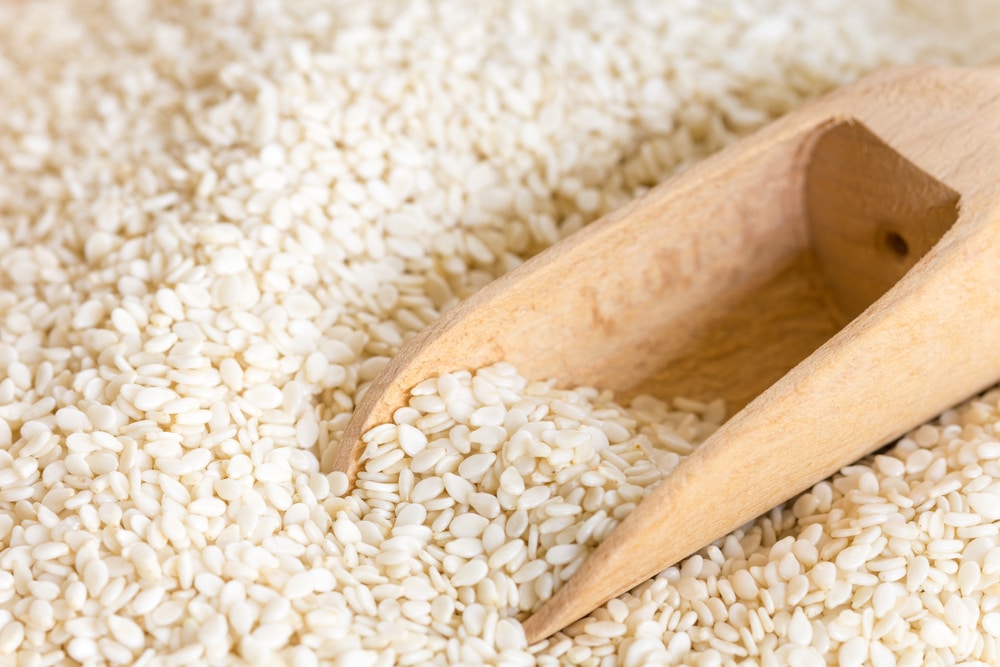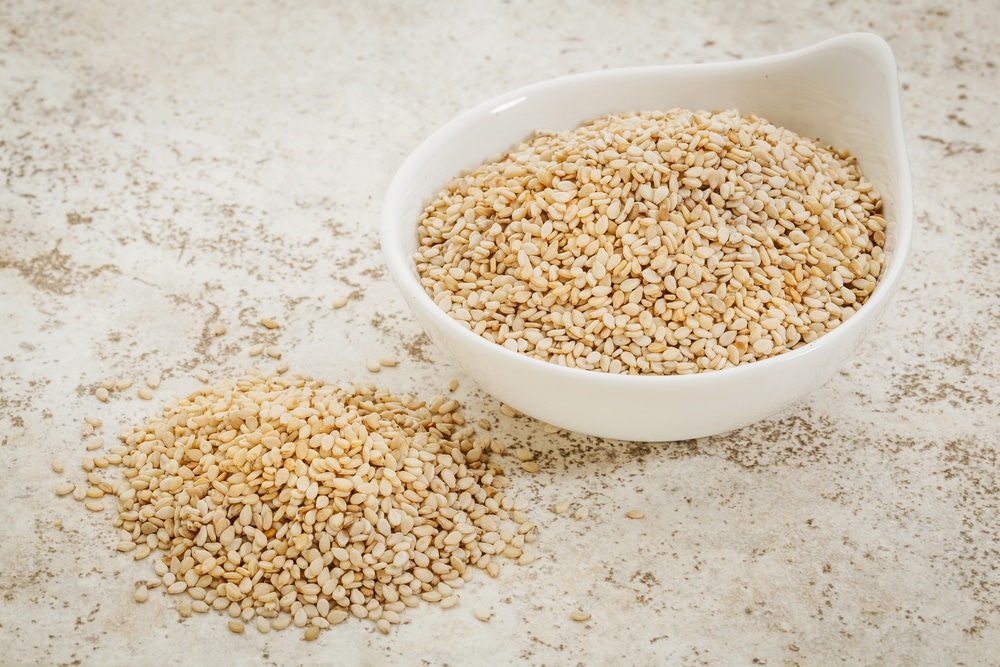If you’re looking to cook a dish using sesame seeds as a primary ingredient, then you may be wondering whether you should use hulled or unhulled sesame seeds. Or maybe you weren’t even aware there was a difference between the two types of seeds!
Difference Between Hulled vs Unhulled Sesame Seeds
The main difference between hulled and unhulled sesame seeds is the presence or absence of the hull, also called a shell or husk. Unhulled seeds are prepared in their natural state with their shells intact, while hulled seeds have their shells removed before use.
The hull itself contains more micronutrients overall. The flavor, however, is slightly bitter and therefore not preferred by everyone. On the other hand, the hulled variety of sesame seeds lose some micronutrients but are more versatile in their uses, as they do not taste as bitter.
People all over the world use both kinds of sesame seeds in their cuisine in different ways. You can sprinkle them on top of a dish, such as chicken wings or pork. You can bake them into and on top of bread with other herbs.
You can ground them into a paste to make tahini–a major ingredient in hummus and baba ganoush. You can also separate the oil and use that to make delicious, Chinese restaurant-style fried rice. There are just so many possibilities!
Comparison Table
| Appearance | Flavor | Macronutrients | Micronutrients | Considerations | |
| Unhulled Sesame Seeds | Brown, red, yellow, black, tan | Nutty, slightly bitter | Higher in calories, fat, protein, and fiber | Higher in calcium, iron, and dietary folate | Higher in oxalic acid (oxalates), may need to avoid if prone to kidney stones |
| Hulled Sesame Seeds | White | Nutty, earthy, buttery | Lose some fat and fiber content with hulling | Higher in vitamin A | Loss of some micronutrients in shell |
Can You Substitute Hulled for Unhulled Sesame Seeds (and Vice Versa)?
The short answer is that, yes, you definitely can. Just as you can substitute hulled sesame seeds for unhulled sesame seeds, you can substitute unhulled sesame seeds for hulled sesame seeds.
The nutritional content and overall flavor are similar enough that you don’t need to run out and buy a new batch if you happen to have the “wrong” seed on hand. Nevertheless, there are a few things you’ll want to consider:
- When the seed still has a hull, it has a different color. The most common type you’ll find is brown in color, though you can also buy black, red, or yellow.
- The hull lends a crunchy texture and a slightly bitter flavor to the seed, but the color itself doesn’t alter the flavor.
- The hulled variety has had its shells removed, which leaves just the seed itself. These are white in color and are softer in texture. They are buttery, earthy, and nutty in flavor.
- If you buy unhulled sesame seeds, but your recipe calls for hulled seeds—and you don’t want to substitute them—it is possible to remove them yourself. There are several ways you can achieve this.
- You can try soaking them in water overnight so that you can remove the husk by hand.
- If you’d prefer to have less water to worry about, you can also try getting the seeds wet, drying them overnight, and then pounding the seed so that the hull breaks open, which you can remove by hand.
What Are Hulled Sesame Seeds?

The sesame plant has been used for centuries by Asian and East African cultures for a variety of purposes: grounded into flour for baking; made into oil for cooking and creating ink blocks; used in shortening and margarine; and it’s been used to manufacture lubricants and pharmaceuticals. It is a versatile, little seed with a big influence on history!
Hulled sesame seeds are the kind you’ve probably eaten before. When the seeds are harvested, they still have their husks. However, during the manufacturing process, these are removed. This doesn’t change their overall nutritional value per se, but it does change some of the micronutrient content and flavor.
Hulled sesame seeds are not as crunchy and hard as unhulled ones. Sesame seeds have a nutty, buttery flavor without the husks, which lends itself well to many dishes. They are a little bitter with the husk, which some people find unappealing.
Hulled sesame seeds have the following nutritional content per tablespoon:
- 60 calories
- 5 grams of fat
- 0.8 grams of saturated fat
- 2 grams of carbs
- 1 gram of fiber
- 2 grams of protein
- 0.7 milligrams of iron
- 11 milligrams of calcium
- 8 micrograms of dietary folate
- 6 units of vitamin A
- 66 milligrams of phosphorus
- 29 milligrams of magnesium
- 35 milligrams of potassium
- 0.9 milligrams of zinc
How to Use Hulled Sesame Seeds
Hulled seeds are great to use in baking or when eaten with salads and stir fry dishes. Because they have a softer texture and nutty flavor, they can be enjoyed as crunchy toppings or as additions to batters and sauces. Here are a few ideas for you to try:
- Sprinkle the seeds on top of baked bread, muffins, or cookies.
- Create your own tahini salad dressing.
- Use the seeds as toppings for smoothies, salads, yogurt, and rice bowls.
- Crush seeds and add to batters for a nutty flavor.
- Bake the seeds with oats for crunchy homemade granola bars.
- Toast the seeds yourself for toppings or mixes.
- Create a fancy dessert like toasted sesame seed and honey gelato.
- Sprinkle the seeds on steamed veggies such as broccoli or stir-fry mixes.
- Use hulled seeds to make tahini paste. This can be used as a base for hummus, baba ganoush, tahini dressings, tahini sauce, and even no-bake cookies with tahini instead of peanut butter!
What Are Unhulled Sesame Seeds?

The entire flowering sesame plant is one of the oldest oilseed crops in the world. It was domesticated approximately 3000 years ago, and since then, the seeds found within its pods have been enjoyed worldwide for their nutty, earthy flavor and versatility in both baking and cooking.
Unhulled seeds are in their natural state; as in, this is how they appear when you harvest them from the plants. The hull, or husk, is like a coating on the seed. Due to the presence of oxalates in the coating, they taste different from hulled seeds.
Oxalate, or oxalic acid, is a compound found in dark leafy greens such as spinach. And while foods high in oxalates tend to be good for you, the oxalic acid itself is not—it has been linked to the formation of kidney stones, and it can reduce the absorption of other minerals, such as calcium.
This isn’t to say you should go out of your way to avoid unhulled sesame seeds or foods high in oxalates in general. Most oxalates will be naturally excreted from your body, and you won’t have to worry. But if you’ve been told by your healthcare provider that you need to be on a low oxalate diet for any reason, then unhulled sesame seeds may need to be nixed from your list in favor of hulled sesame seeds.
Unhulled sesame seeds have the following nutritional content per tablespoon:
- 79 calories
- 7 grams of fat
- 1 gram of saturated fat
- 3 grams of carbohydrates,
- 2 grams of fiber
- 3 grams of protein
- 1.3 milligrams of iron
- 88 milligrams of calcium
- 9 micrograms of dietary folate
- 1 unit of vitamin A
- 57 milligrams of phosphorus
- 32 milligrams of magnesium
- 42 mg potassium
- 0.7 mg zinc
How to Use Unhulled Sesame Seeds
Owing to their slightly bitter flavor, unhulled seeds are great when mixed into other dishes. Just a few ways people like to use unhulled seeds include making sesame oil, batter for fried dishes, and spice mixes.
Here are a few ideas to try:
- Create your own sesame oil.
- Crush them with other nuts, salts, and spices to make dukkah.
- Make Japanese-style sesame seed balls.
- Make fish batter using sesame oil or crush sesame seeds for sesame-crusted fried fish.
- Use sesame oil to make authentic Chinese restaurant-style fried rice.
- Try using black sesame seeds as toppings for noodle- or rice-based dishes.
- Top your own rolled sushi with toasted sesame seeds.
- Make tahini—it will take on the color of the unhulled seed and have a more complex flavor.
- If you like anything pickled, try topping it with a sprinkle of sesame seeds!
Final Thoughts
Whether you’re new to cooking and baking with sesame seeds or you’re looking to expand your repertoire, it’s essential to understand the benefits and drawbacks that hulled and unhulled sesame seeds can provide. But it’s also vital to recognize the various ways you can use this versatile ingredient in your kitchen!
Disclaimer: You should note that some people are allergic to sesame seeds and oil, as with any other kind of seed or oil. As long as you do not have an allergy to sesame, these recipe ideas are safe for consumption.
Related article:







